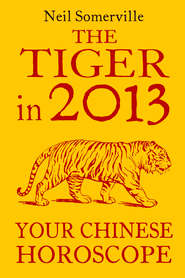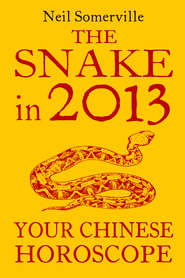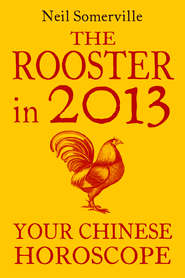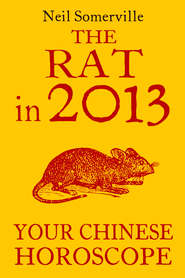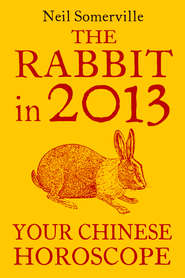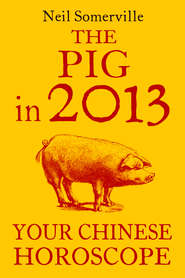По всем вопросам обращайтесь на: info@litportal.ru
(©) 2003-2024.
✖
Your Chinese Horoscope 2016: What the Year of the Monkey holds in store for you
Автор
Год написания книги
2018
Настройки чтения
Размер шрифта
Высота строк
Поля
The Chinese Years (#ulink_26da0e3f-01fa-5efc-b8f9-07ea56b84f9d)
Welcome to the Year of the Monkey (#ulink_b191003c-2bef-5b7f-8e43-68255a6d7644)
The Rat (#ulink_91ccf488-6a30-5946-8b6a-e459923a85e7)
The Ox (#ulink_d9188b50-811b-512a-93ad-03ad2db29873)
The Tiger (#ulink_1250d25e-d9ab-5077-be53-b3ce408228e4)
The Rabbit (#litres_trial_promo)
The Dragon (#litres_trial_promo)
The Snake (#litres_trial_promo)
The Horse (#litres_trial_promo)
The Goat (#litres_trial_promo)
The Monkey (#litres_trial_promo)
The Rooster (#litres_trial_promo)
The Dog (#litres_trial_promo)
The Pig (#litres_trial_promo)
Appendix (#litres_trial_promo)
Relationships between the Signs (#litres_trial_promo)
Your Ascendant (#litres_trial_promo)
How to Get the Best from your Chinese Sign and the Year (#litres_trial_promo)
A Closing Thought (#litres_trial_promo)
About the Publisher (#litres_trial_promo)
Acknowledgements (#uc18453a9-841d-5614-b558-9b1961185a67)
In writing Your Chinese Horoscope 2016 I am grateful for the assistance and invaluable support that those around me have given.
I would also like to acknowledge Theodora Lau’s The Handbook of Chinese Horoscopes (Harper & Row, 1979; Arrow, 1981), which was particularly useful to me in my research.
In addition to Ms Lau’s work, I commend the following books to those who wish to find out more about Chinese horoscopes: Kristyna Arcarti, Chinese Horoscopes for Beginners (Headway, 1995); Catherine Aubier, Chinese Zodiac Signs (Arrow, 1984), series of 12 books; E. A. Crawford and Teresa Kennedy, Chinese Elemental Astrology (Piatkus Books, 1992); Paula Delsol, Chinese Horoscopes (Pan, 1973); Barry Fantoni, Barry Fantoni’s Chinese Horoscopes (Warner, 1994); Bridget Giles and the Diagram Group, Chinese Astrology (HarperCollinsPublishers, 1996); Kwok Man-Ho, Complete Chinese Horoscopes (Sunburst Books, 1995); Lori Reid, The Complete Book of Chinese Horoscopes (Element Books, 1997); Paul Rigby and Harvey Bean, Chinese Astrologics (Publications Division, South China Morning Post Ltd, 1981); Ruth Q. Sun, The Asian Animal Zodiac (Charles E. Tuttle Company, Inc., 1996); Derek Walters, Ming Shu (Pagoda Books, 1987) and The Chinese Astrology Workbook (The Aquarian Press, 1988); Suzanne White, The New Astrology (Pan, 1987), The New Chinese Astrology (Pan, 1994) and Chinese Astrology Plain and Simple (Eden Grove Editions, 1998).
Introduction (#uc18453a9-841d-5614-b558-9b1961185a67)
The origins of Chinese horoscopes have been lost in the mists of time. It is known, however, that oriental astrologers practised their art many thousands of years ago and even today Chinese astrology continues to fascinate and intrigue.
In Chinese astrology there are 12 signs named after 12 different animals. No one quite knows how the signs acquired their names, but there is one legend that offers an explanation. According to this legend, one Chinese New Year the Buddha invited all the animals in his kingdom to come before him. Unfortunately, for reasons best known to the animals, only 12 turned up. The first to arrive was the Rat, followed by the Ox, Tiger, Rabbit, Dragon, Snake, Horse, Goat, Monkey, Rooster, Dog and finally Pig. In gratitude, the Buddha decided to name a year after each of the animals and that those born during that year would inherit some of the personality of that animal. Therefore those born in the year of the Ox would be hardworking, resolute and stubborn, just like the Ox, while those born in the year of the Dog would be loyal and faithful, just like the Dog. While it is not possible that everyone born in a particular year can have all the characteristics of the sign, it is incredible what similarities do occur, and this is partly where the fascination of Chinese horoscopes lies.
In addition to the 12 signs of the Chinese zodiac there are five elements and these have a strengthening or moderating influence upon the signs. Details about the effects of the elements are given in each of the chapters on the signs.
To find out which sign you were born under, refer to the tables on the following pages. As the Chinese year is based on the lunar year and does not start until late January or early February, it is particularly important for anyone born in those two months to check carefully the dates of the Chinese year in which they were born.
Also included, in the appendix, are two charts showing the compatibility between the signs for personal and business relationships and details about the signs ruling the different hours of the day. From this it is possible to locate your ascendant and, as in Western astrology, this has a significant influence on your personality.
In writing this book I have taken the unusual step of combining the intriguing nature of Chinese horoscopes with the Western desire to know what the future holds, and have based my interpretations upon various factors relating to each of the signs. Over the years in which Your Chinese Horoscope has been published I have been pleased that so many have found the sections on the forthcoming year of interest and hope that the horoscope has been constructive and useful. Remember, though, that at all times you are master of your own destiny.
I sincerely hope that Your Chinese Horoscope 2016 will prove interesting and helpful for the year ahead.
The Chinese Years (#uc18453a9-841d-5614-b558-9b1961185a67)
Rabbit 14 February 1915 to 2 February 1916
Dragon 3 February 1916 to 22 January 1917
Snake 23 January 1917 to 10 February 1918
Horse 11 February 1918 to 31 January 1919
Goat 1 February 1919 to 19 February 1920
Monkey 20 February 1920 to 7 February 1921
Rooster 8 February 1921 to 27 January 1922
Dog 28 January 1922 to 15 February 1923
Pig 16 February 1923 to 4 February 1924
Rat 5 February 1924 to 23 January 1925
Ox 24 January 1925 to 12 February 1926
Tiger 13 February 1926 to 1 February 1927
Rabbit 2 February 1927 to 22 January 1928
Dragon 23 January 1928 to 9 February 1929
Snake 10 February 1929 to 29 January 1930
Horse 30 January 1930 to 16 February 1931
Goat 17 February 1931 to 5 February 1932






